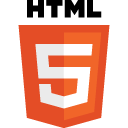We want HTML5 and other open standards by the WWW Consortium to become the universal computer interface platform on any decive, anywhere and for anyone.

The official HTML5 logo
HTML5 has clear advantages that beats any other options in so many ways:
Free and open
- based on standards anybody can read and use without restrictions
- standards are drafted in the open and anybody can contribute
- governed by a vendor-neutral organisation
- respects software freedom and data freedom and net neutrality
Universal and connected
- Really, the browser is already everywhere
- No other UI toolkit is as universal as HTML (although Qt comes close)
- HTML5 based applications are at home in a networked environment
Easy and featureful
- HTML, CSS and JavaScript are easy to learn and quick to get useful with
- …and it has been learnt by more people than any other programming language
- As developers can easily read anybody else’s code, innovation and learning is particulary easy
- To develop, all you need is a browser and a text editor
- In HTML5 there are all the features we, need based on a global experience
Flexible and expandable
- HTML/CSS/JavaScript can be used in very flexible ways to make almost anything
- …and it can be expanded with new tags, JavaScript APIs and even HTTP mechanisms without braking compatibility
- HTML standards are written to be both backwards and forwards compatible
- Developers can flexibly choose what to do on the server and what to do on the client
- Servers and clients can be updated without any central control or loss of functionality
- Data, presentation and logic are naturally separated to provide a clean default architecture
Semantic and discoverable
- HTML interfaces are semantic by definition
- …which means they can be indexed and discovered
Trustable and transparent
- All code on the client side is viewed and audited by the security aware individual or organisation
- Browser technologies and the http protocols been proven to be robust and secure enough
To learn more about HTML5 features, the rationale behind them and the evolution of HTML5, read the excellent book by Mark Pilgrim: Dive into HTML5, which you can read online for free too. This book covers all the most important things and you should absolutely read it first. Only after that if you want to learn more, read up for example at HTML5rocks.com.
If you are about to start a new web project, please consider using the HTML5 boilerplate as your template. If you are about to start a new multi platform coding project, please consider using Apache Cordova a.k.a. PhoneGap.



One thought on “The HTML5 Manifest”